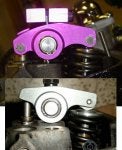My sons heads coming off to get a new head gasket and timing chain. While there I plan on sending it to the shop to get checked out and a set of Chevy positive valve stem seals.
While there I was thinking of just getting it a quick rebuild, and after talking to the shop and looking over prices of "exotic" Opel valves and such from europe. It will be cheaper, faster and easier to just go "Chevy big valve". But damn if I can find a "Concise" recipe on any thread..
I know due to a few posts (and my slipping memory of many many conversations on the subject.. that :
So what I wanted to do here.. was for the average Opel owner who is investing about $2000 into a rebuild of a street Opel.
So to eliminate variables and side paths that will lead too. Let's assume.. A stock 1.9L cam ( Or maybe a 2.0 or a Torquer, noting exotic ) and 2.0L pistons, 2" exhaust and 32/36.
I am looking for what basically would be an upgrade for a 1.9L head to 2.0L valves. But using off the shelf components a local machine shop could get. Basically best bang for the buck. What can I improve at the same cost as a standard rebuild for a little more performance from a local machine shop.
Long story short.. anyone know the "recipe" ?
I would assume:
Chevy Valve guides ?
Chevy 1.72" Intake
Chevy 1.5" Exhaust
Chevy Valve seats
Chevy Positive Valve Stem seals ( Having the valve guide boss cut down to fit them )
Reuse Late model Opel Springs and keepers ? Pontiac OR ...?
If you have to replace the rocker studs you could use ?
Rockers ?
While there I was thinking of just getting it a quick rebuild, and after talking to the shop and looking over prices of "exotic" Opel valves and such from europe. It will be cheaper, faster and easier to just go "Chevy big valve". But damn if I can find a "Concise" recipe on any thread..
I know due to a few posts (and my slipping memory of many many conversations on the subject.. that :
and of course Bob..
Too many threads go deep into the weeds or look at race applications or go off topic, or throw too many variables into the mix. I am not looking for that.
So what I wanted to do here.. was for the average Opel owner who is investing about $2000 into a rebuild of a street Opel.
So to eliminate variables and side paths that will lead too. Let's assume.. A stock 1.9L cam ( Or maybe a 2.0 or a Torquer, noting exotic ) and 2.0L pistons, 2" exhaust and 32/36.
I am looking for what basically would be an upgrade for a 1.9L head to 2.0L valves. But using off the shelf components a local machine shop could get. Basically best bang for the buck. What can I improve at the same cost as a standard rebuild for a little more performance from a local machine shop.
Long story short.. anyone know the "recipe" ?
I would assume:
Chevy Valve guides ?
Chevy 1.72" Intake
Chevy 1.5" Exhaust
Chevy Valve seats
Chevy Positive Valve Stem seals ( Having the valve guide boss cut down to fit them )
Reuse Late model Opel Springs and keepers ? Pontiac OR ...?
If you have to replace the rocker studs you could use ?
Rockers ?

















